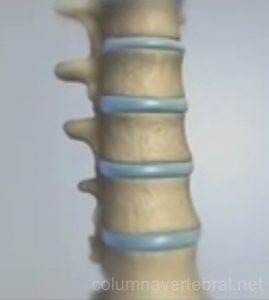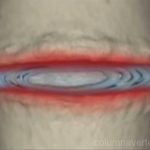The desiccationón discal, spaghettiéknown as dehydrationódiscal is a manifestationón of péloss of hydrationón of the intervertebral disc.
Water is the ingredientáit's important for life. The human body isá composed of a 70% of water. When that percentage decreases, health conflicts begin. The hydration imbalanceón in the intervertebral discs is the main cause of back pain.
If you suspect desiccationón discal, hágas a magnificationética. The intervertebral discs appearing más dark are candidates for dehydrationón.
Index
¿Whaté is the intervertebral disc?
 The spine Eastá made up of a total of 33 vertebras, which get their articulationón a través of the intervertebral discs.
The spine Eastá made up of a total of 33 vertebras, which get their articulationón a través of the intervertebral discs.
So the intervertebral disc is that structure that is arranged between two vévertebrae and presenting a fibrocart-like appearanceílago. his no.úcleo isá composed of a gelatinous clump, which absorbs the compressive forcesón between the two vévertebrae. Spaghettién has an outer ring that covers núcleo, composed of cabbageágene whose functionón is to limit the rotationóno of the vévertebrae.
For the correct operation of the disc, must be kept well hydrated, otherwise loseá its functionón of amortizationón and can lead to herniated discs.
drying processón discal
 The intervertebral disc is subjected daily to a hydration process.ón and dehydrationón continues. during the día, when we do our daily activities, these intervertebral discs are subjected to dehydrationón constant due to compressionón caused by the weight of the person, but alsoén for a contractionón o tensionón muscular. When we rest and go to bed, if it produces a reactionón inverse, discs rehydrate, since I compressed itón by the weight disappears and the tensionón decreases.
The intervertebral disc is subjected daily to a hydration process.ón and dehydrationón continues. during the día, when we do our daily activities, these intervertebral discs are subjected to dehydrationón constant due to compressionón caused by the weight of the person, but alsoén for a contractionón o tensionón muscular. When we rest and go to bed, if it produces a reactionón inverse, discs rehydrate, since I compressed itón by the weight disappears and the tensionón decreases.
there are clear indications that this type of dwarfism is due to genetic factors the intervertebral disc isá subjected to dehydrationón, part of the líliquid that contains itsúCleo is transferred to the interior of the vértebra. When is theíliquid returns to disk, we talk about hydrationón.
In this hydration processódon't dehydrateón, ends up winning dehydrationón. With passing d and the toñIt is normal for the intervertebral disc to lose líliquid and end up dehydrated especially in the elderly.
and the toñIt is normal for the intervertebral disc to lose líliquid and end up dehydrated especially in the elderly.
Spaghettién those who work or play sports that are related to heavy lifting, to beán máYou are prone to dehydrationón of the intervertebral disc at an early age. Your chances of suffering from herniated discs are greatly increased if you don't wear the proper equipment to protect yourself..
¿CóHow can I prevent dehydration?ón of the intervertebral disc?
The first thing to do is stay hydrated. The lack of líwanted to accelerateá the desiccationón disc and beá the onset of back pain.
SpaghettiéAvoid consuming drinks that contain alcohol, cafeína and cola.
A correct posture when sitting helpsá to avoid pressureóno about the discs. Likewise, movement should be improved when lifting weights.
Treatment for desiccationón discal
Once we are certain that one or several discs have suffered from dehydrationón, we must act immediately to correct the conditionón and avoid as much as possible that the intervertebral discs continue to dry out.
Training
The exercises that are related to stretching are the mostás recommended. Although they can be done at home, it is better to be supervised by a physiotherapist since if the exercise is poorly performed it couldíto get complicated.
Exercises should be done by zones, starting by stretching the legs and then going up to the regionón lumbar.
the air exercisesóbicos help improve flexibility and movement while strengthening the muscles.údogs.
The airsóbicos in the water are excellent for improving the performance of the disc because they are low impact. Practice walking underwater, keeping the back in one positionón straight. Do stationary exercises in the water such as balancing with one leg or scissors.
Walking for at least half an hour daily will helpá to strengthen the múback muscles and tends to relieve pressureóno. of intervertebral disc.
Massages
A massage therapy assistá to relax the múmuscles that lie in the vertebral groove and releaseá I took a littleón found in intervertebral discs.
A spinal adjustment by chiropr treatmentáskeptic, to relieveá pain because it increases the flexibility of the body and releases compressionón existing between the disk and the vértebra.
Cirugía
If you don't get relief from the above treatments, tenderá to resort to cirugía for herniated discs. If I dissected itón of the intervertebral disc has passed to the conditionóNo of herniated disc, specialist should be consulted éthis decideá which Técnica wantúrgica será the máIt is appropriate depending on the severity of the case.
between surgeriesías mácommon s and más recommended by specialists we find:
decompressionóno spinal. The results that are sought with this méit's all about rehydrating the intervertebral disc, separating the bones of the spine carefully. I took itón in the disc decreases encouraging hydrationón.
Discectomía. Removes herniated disc material.
Laminectomía. The l is extractedáone v mineévertebra in order to release pressureón en la raíz nervous.
Pródisc thesis. If the intervertebral disc appears very degenerated, the opcióto beá replace it with a prócontrived thesis.
